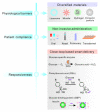Roadmap on nanomedicine
- PMID: 33043901
- PMCID: PMC7612035
- DOI: 10.1088/1361-6528/abaadb
Roadmap on nanomedicine
Abstract
Since the launch of the Alliance for Nanotechnology in Cancer by the National Cancer Institute in late 2004, several similar initiatives have been promoted all over the globe with the intention of advancing the diagnosis, treatment and prevention of cancer in the wake of nanoscience and nanotechnology. All this has encouraged scientists with diverse backgrounds to team up with one another, learn from each other, and generate new knowledge at the interface between engineering, physics, chemistry and biomedical sciences. Importantly, this new knowledge has been wisely channeled towards the development of novel diagnostic, imaging and therapeutic nanosystems, many of which are currently at different stages of clinical development. This roadmap collects eight brief articles elaborating on the interaction of nanomedicines with human biology; the biomedical and clinical applications of nanomedicines; and the importance of patient stratification in the development of future nanomedicines. The first article reports on the role of geometry and mechanical properties in nanomedicine rational design; the second articulates on the interaction of nanomedicines with cells of the immune system; and the third deals with exploiting endogenous molecules, such as albumin, to carry therapeutic agents. The second group of articles highlights the successful application of nanomedicines in the treatment of cancer with the optimal delivery of nucleic acids, diabetes with the sustained and controlled release of insulin, stroke by using thrombolytic particles, and atherosclerosis with the development of targeted nanoparticles. Finally, the last contribution comments on how nanomedicine and theranostics could play a pivotal role in the development of personalized medicines. As this roadmap cannot cover the massive extent of development of nanomedicine over the past 15 years, only a few major achievements are highlighted as the field progressively matures from the initial hype to the consolidation phase.
Figures









References
-
- Key J, Palange AL, Gentile F, et al. Singh J, Decuzzi P. Soft Discoidal Polymeric Nanoconstructs Resist Macrophage Uptake and Enhance Vascular Targeting in Tumors. ACS Nano. 2015;9(12):11628–11641. - PubMed
-
- Peer D, Karp JM, Hong S, et al. Margalit R, Langer R. Nanocarriers as an emerging platform for cancer therapy. Nature Nanotechnology. 2007;2(12):751–760. - PubMed
Grants and funding
LinkOut - more resources
Full Text Sources
Research Materials
Miscellaneous
